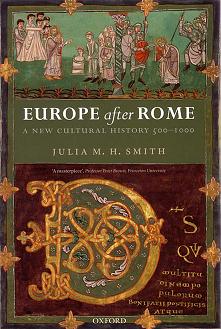
Europe after Rome
Julia M. H. Smith
384 pages including index
published in 2005
To be honest I only took this book out of the library because there was little else in the way of good history books that day. Europe after Rome was a bit of a safe choice, on a subject I’d already read a lot about and if perhaps it would offer little new knowledge, I knew I would at least enjoy the refresher. I had no high hopes for this book, but sometimes gambles pay off — this was one of these cases. Because Europe after Rome is, as the subtitle makes clear, A New Cultural History of the period between 500 and 1000 CE, between the “fall” of the Roman Empire and the start of the “true” Middle Ages.
Traditionally historians have treated this period as a transitional one between this two high points of civilisation, as a story of collapse and rebound, when the seeds were laid for what would become the familiar nations of modern Europe: France, Germany, England. Europe after Rome abandons this teleological view deliberately in favour of an approach that follows three interpretative threads: the role of the Roman heritage in the formation of Early Medieval cultures/policies, the diversity of experience for these cultures — this is not a book about European culture, but about the cultures of Europe — and finally, the dynamism of these cultures, all changing a lot over this period, which Smith is careful never to imply as meaning that these were evolving towards a set goal. To help her with this approach, she takes care to look at a wide range of European experiences, both geographically by looking at a region that reaches from Spain to Scandinavia and from Italy to Hungary and by crosscutting between cultures within each chapter for her examples.
Before I go into the structure of Europe after Rome, I should point out another relatively unusual feature, the care with which Smith has made this a history of all the people who lived in the Early Middle Ages, women as well as men. It’s easy to slip into historical narratives that priviledge the male experience, if only because traditional histiography and contemporary sources both tend to this already. It takes effort to seek out and highlight female experiences as well and more so to incorperate them as naturally as Smith has done here. You almost need to have it pointed out to you to see how unusual this is.
Smith builds up her history from the bottom up, starting with the fundamentals: speaking and writing, living and dying, moving through affinies: friends and relations, men and women, to resources: labour and lordship, getting and giving and finally on to ideologies: kingship and Christianity, Rome and the peoples of Europe. The focus of Europe after Rome at first therefore lies squarely on the common people and their experiences, only slowly moving up the social scale to the kings and popes who are usually in the spotlights. Each chapter is divided into several subchapters, looking at specific aspects of the subject under discussion. So the chapter on friends and relatives looks at identity, friends by blood and honour and vengeance, while the chapter on labour and lordship in turn looks at servitude and freedom, peasants and lords and the search for status, each building logically on its predecessor.
In every aspect of Early Medieval life Smith examines, the influence of Christianity is clearly visible. What’s equally clear however is how diverse Christianity was in this period. Even apart from the differences between the “western” church of Rome and the “eastern” Byzantine church, there’s a lot of diversity in how people experienced Christianity. It quickly becomes obvious that much of what Christianity means to its followers was decided locally, often incorporating already existing traditions and rituals and sometimes based on no more than secondhand information about Christian beliefs. A far cry from the image I sort of had of an Europe ruled by Catholicism.
Though there is something of a broad chronological sweep in Europe after Rome, this is not a chronologically orientated history, so you do need to have some rough idea of what happened in the Early Middle Ages, of who the various players were, to get the most out of it. It is full of interesting little facts, asides and anecdotes, like the one about Boniface of Canossa on his way to pick up his bride, who shod his horse with silver shoes, deliberately made easy to lose so “people may know who he was”. Such a story is not just interesting in itself, it’s also a good illustration of, in this case, the important role gift giving and shows of generosity played in establishing a noble man’s power and worth.
So yeah, a good addition to all the other books about Late Antiquity/the Early Middle Ages and highly recommended to anybody. Sometimes a gamble pays out very well indeed…
No Comments